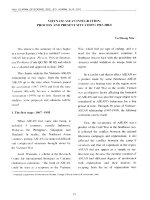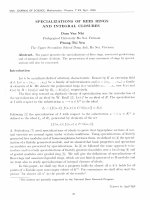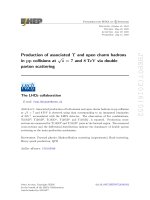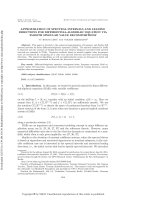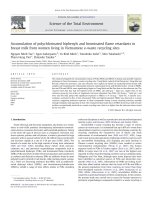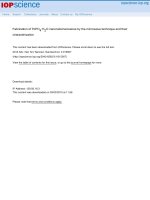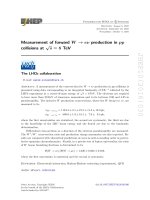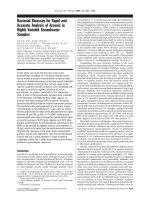DSpace at VNU: Mechanism of two rapid and long-runout landslides in the 16 April 2016 Kumamoto earthquake using a ring-shear apparatus and computer simulation (LS-RAPID)
Bạn đang xem bản rút gọn của tài liệu. Xem và tải ngay bản đầy đủ của tài liệu tại đây (8.46 MB, 10 trang )
Recent Landslides
Landslides
DOI 10.1007/s10346-016-0748-9
Received: 22 July 2016
Accepted: 11 August 2016
© Springer-Verlag Berlin Heidelberg 2016
Khang Dang I Kyoji Sassa I Hiroshi Fukuoka I Naoki Sakai I Yuji Sato I Kaoru Takara I Lam Huu
Quang I Doan Huy Loi I Pham Van Tien I Nguyen Duc Ha
Mechanism of two rapid and long-runout landslides
in the 16 April 2016 Kumamoto earthquake using
a ring-shear apparatus and computer simulation
(LS-RAPID)
Abstract Around hundred landslides were triggered by the Kumamoto earthquakes in April 2016, causing fatalities and serious
damage to properties in Minamiaso village, Kumamoto Prefecture,
Japan. The landslides included many rapid and long-runout landslides which were responsible for much of the damage. To understand the mechanism of these earthquake-triggered landslides, we
carried out field investigations with an unmanned aerial vehicle to
obtain DSM and took samples from two major landslides
(Takanodai landslide and Aso-ohashi landslide) to measure parameters of the initiation and the motion of landslides. A series of
ring-shear tests and computer simulations were conducted using a
measured Kumamoto earthquake acceleration record from KNet
station KMM005, 10 km west of Aso-ohashi landslide. The research results supported our assumed mechanism of slidingsurface liquefaction for the rapid and long-runout motion of these
landslides.
Keywords Kumamoto landslides . Earthquake-induced
landslides . UAV photos . Ring-shear apparatus . Computer
simulation . LS-RAPID
Introduction
The 2016 Kumamoto earthquakes were a series of earthquakes,
including two main shocks which occurred beneath Kumamoto
City, Kumamoto Prefecture, Kyushu Region, Japan. A M6.5
earthquake occurred at 21:26 JST on April 14, and a M7.3 earthquake struck at 01:25 JST on April 16 (National Research Institute for Earth Science and Disaster Resilience, NIED). The nearfault strong ground motion was reported by Furumura (2016).
The two earthquakes killed at least 49 people and injured about
3000 others. More than 44,000 people were evacuated from
their homes due to the disaster. These two events generated
most of the building damage and many of the landslides in
the Kumamoto area. According to Japan’s Ministry of Land,
Infrastructure, Transport and Tourism, at least 97 landslide
locations were confirmed in the Aso area. Among these
earthquake-triggered landslides, the largest landslides were two
very substantial slope failures (Fig. 1). One was located on the
National Road 57 and destroyed an important bridge. The other
occurred near the Aso volcanological laboratory of Kyoto University and destroyed seven houses. We carried out a field
investigation of these two landslides using an unmanned aerial
vehicle (UAV) and took soil samples from the landslide areas.
The UAV images were analyzed with Agisoft PhotoScan software
to make orthorectified images and DSM models. To examine
potential initiation and moving mechanisms of these landslides,
dynamic ring-shear tests were performed on the remolded soil
samples, simulating the cyclic normal and shear stresses in the
landslides using measured earthquake waves. Finally, all
achieved parameters and DSM models were input to the LSRAPID software to simulate these landslides.
The Takanodai landslide
An overview of the Takanodai landslide occurred on 21 May 2016
(more than a month after the event) is presented in Fig. 2. This
area includes three landslide blocks on the hillslope below the Aso
volcanological laboratory of Kyoto University in Minamiaso village, Kumamoto Prefecture. The largest one destroyed seven houses of the Takanodai housing complex (yellow zone, identified by
comparing Google Earth images before and after the event) and
killed five people (Ministry of land, infrastructure, transport and
tourism). After triggering by earthquake, this landslide moved at
least 150 m.
Kumamoto prefectural government had created landslide
hazard maps based on national government standards for
landslide prevention using the following criteria: steep areas
at least 5 m high with a slope of 30 degrees or more, areas
below a rapid mountain stream that has formed an alluvial
fan, and areas where landslides have occurred or are at risk
of occurring. The slopes in the Takanodai housing complex
area did not meet even one of these criteria (the slope in this
area is less than 30 degrees and there was no evidence of past
landslides), so this area was not designated as a landslide
hazard zone (The Mainichi newspapers 2016). The reasons
and mechanism of this landslide will be examined in the
latter part of this paper based on the analysis of collected
data, the seismic-loading test, and computer simulation model
(LS-RAPID).
A central longitudinal section A–B through the Takanodai
landslide is presented in Fig. 2b based on field investigation; the
digital surface model (DSM) generated by UAV photos after the
landslide and the 5-m topographical map before the landslide. This
landslide moved with a slope angle of 11.3 degrees and an average
apparent friction angle of 9.5 degrees and a maximum depth of
around 20 m. Hence, this landslide can be classified as a gentle
sloping, moderately shallow landslide (International Consortium
on Landslide 2016).
Two samples were taken from the collapsed area of
Takanodai landslide (Fig. 2), which was mainly composed of
strongly weathered lava. Figure 3a, b presents the sampling site
of Aso-1 and Aso-2 in which the soils change in color from
brown (upper layer, sample Aso-1) to black (lower layer, sample
Aso-2). This phenomenon expresses the oxidation state of iron
contained in the soil: the lower layer is black in color from iron
Landslides
Recent Landslides
Fig. 1 Monitored peak acceleration of the M7.3 Kumamoto earthquake (from the National Research Institute for Earth Science and Disaster Resilience, NIED) and locations
of the epicenter, earthquake record stations, and the two studied landslides (from Google Earth images)
present in the reduced state (Fe2+) from being submerged in
groundwater, while the oxidized part is brown (from Fe3+ )
(Fukuoka et al. 2004; Sassa et al. 2005).
The grain-size distributions of samples Aso-1 and Aso-2 from
this landslide are plotted in Fig. 3c, along with those of samples
Aso-3 and Aso-4. The two samples are quite similar although
sample Aso-1 contained a slightly higher proportion of sand than
Aso-2. According to other basic tests, samples Aso-1 and Aso-2 had
specific gravities of 2.66 and 2.64 g/cm3, respectively. To estimate
the unit weight of Aso soils, we consolidated sample Aso-1 in the
ring-shear apparatus in a saturated condition. The consolidation
stress, sample height, dry unit weight, and saturated unit weight
are shown in Fig. 2d. The saturated unit weight of the sample was
approximately 15.4 kN/m3 at 350 kPa consolidation stress, and
15.7 kN/m3 at 800 kPa. The dry unit weight was 8.9 and 9.4 kN/
m3, respectively. We used a single value of 15 kN/m3 for the entire
area in our numerical simulation.
Grain-size distributions of these two samples Aso-3 and Aso-4 are
also presented in Fig. 3c. They show close similarity (in terms of sizedistribution curve) with the samples Aso-1 and Aso-2 taken from the
first landslide area. The brown sample (Aso-3) had a specific gravity of
2.66 g/cm3, and black sample (Aso-4) of 2.64 g/cm3.
Figure 4b shows the longitudinal cross section of the Asoohashi landslide (line E-F). Green line is the section before the
landslide and the red line is the section after the landslide. The
average slope angle of the sliding surface was 35.0 degrees and
the average apparent friction angle was about 24.5 degrees. The
maximum depth was measured as approximately 35 m. The
landslide mass traveled a distance of about 800 m, deposited
much debris onto National Route 57, and severely damaged a
section of the JR Hohi railway track running parallel to the
highway (The Japan Time 2016). This landslide also destroyed
an important bridge connecting Minamiaso village to the city of
Kumamoto.
The Aso-ohashi landslide
The second landslide is situated at the western tip of the caldera of
Mount Aso. It was named after the 200-m long Aso-ohashi bridge
that formerly spanned the 80-m deep gorge of the Kurokawa River
before it was destroyed by the landslide on April 16 during the
magnitude 7.3 earthquake.
This area is also characterized by soft ground composed of
weathered volcanic cohesive soil (Geological map display system
of Geological Survey of Japan, AIST, 2016). In order to obtain the
soil characteristics and to compare with the samples from the first
landslide area, two similar soil samples were taken on the left hand
side of the landslide body (seen from the upper slope to down
slope in Fig. 4a). The soil layers at this sampling location were
visually similar to those at the first sampling location and also
varied from black color (lower layer) to brown color (upper layer).
Ring-shear tests
A high-stress, dynamic-loading, undrained ring-shear apparatus
(ICL-2, Sassa et al. 2014a, b) was used to test the likely behavior
of the brown sample Aso-1 during the M7.3 earthquake. This
sample was taken from the area where sliding was assumed to
have occurred. Information about the ring-shear apparatus ICL2 and its testing procedures are available in Sassa et al. (2014a,
b).
The ring-shear test was conducted according to the following
procedure:
Landslides
&
&
Firstly, we saturated the sample (taken from the soil layer where the
sliding surface was formed) by de-air system 1 day before testing.
Then, the sample was placed in the shear box, saturated by
replacing pore air by CO2 gas and then replacing CO2 by de-
Fig. 2 Plan and central cross section of the Takanodai landslide area, Minamiaso village, Kumamoto Prefecture (the map was made from UAV images using Agisoft
PhotoScan software). a The red lines show the borders of the landslides, the yellow lines (A–B) is the central cross section line. b The green line presents the ground
surface before the landslide and the brown line presents the sliding surface with an inclination of 11.3 degrees
&
&
aired water. The pore pressure parameter (BD = Δu/Δσ) was
measured to confirm full saturation (BD ≥ 0.95) (Sassa et al. 2010).
The normal stress acting on the sample before and during
shearing was set according to the self-weight of the soil layer.
Finally, a cyclic-loading and seismic-loading test using the
simulated Kumamoto earthquake waveform was performed
under undrained conditions. Shear resistance, pore water pressure, and vertical displacement of the sample were monitored
along with the progress of shear displacement.
Undrained cyclic-loading test
This test was conducted to examine dynamic behavior of the
sample and investigate the seismic acceleration necessary to
cause the landslides (Fig. 5a, b). Initially, the Aso-1 sample was
fully saturated (BD = 0.94) and consolidated at around 450 kPa
normal stress, and 250 kPa shear stress in drained condition
(the test was carried out before obtaining the soil unit weight,
so we tentatively estimated these values of normal stress and
shear stress). This initial stress state corresponded to the slope
angle of 35o. Then, the shear box was changed to the undrained
condition by closing the valves and applied with the control
signal for the undrained cyclic-loading test (green line in
Fig. 5b). During the test, normal stress was kept constant (black
line) and shear stress was loaded step by step until 5 cycles with
sine wave, in which each step was increased ±30 kPa. It was
expected that the sample would fail before the loading of fifth
cycle when the final shear stress reached 400 kPa. After that,
five loading cycles that were kept constant before the cyclic
shear stress was reduced to 250 kPa in four steps. The shear
resistance, pore water pressure, and shear displacement are
plotted in Fig. 5b by red line, blue line, and purple line, respectively. The shear stress reached the failure line and decreased
after the peak of the third loading cycle due to generation of
Landslides
Recent Landslides
(b)
(a)
(d)
(c)
Grain-size distribution
Unit weight
Fig. 3 Sampling site of Aso-1 and Aso-2 (a, b), grain-size distribution (c), and unit weight (d) of the samples taken from the two landslides
excess pore water pressure. As shown in the stress path, the
peak shear resistance was reached at 325 kPa, friction angle
during motion of 37.2o. The necessary seismic acceleration to
cause failure was estimated to be 168 cm/s/s. The pore water
pressure in this test was not well monitored due to the material
being fine. The stress path show the steady-state shear resistance is 42.1 kPa. Shearing stopped after 300 s and the shear
displacement reached 10 m.
Undrained seismic-loading test with the simulated Kumamoto earthquake waveform
This test is the most advanced and complicated test of the new
ring-shear apparatus to simulate an earthquake-induced landslide (Dang 2015). The earthquake record was obtained from
KMM005, an observation station of K-NET (Kyoshin network),
which is a nation-wide strong motion seismograph network
operated by the National Research Institute for Earth Science
and Disaster Resilience (NIED). KMM005 is located at 10 km
west of the landslide area and 25 km northeast of the earthquake epicenter. The monitored nearby maximum seismic accelerations are 420 cm/s/s at KMM007, 827 cm/s/s at KMM006,
525 cm/s/s at KMM005, and 346 cm/s/s at KMM004. We adopted
the monitored seismic record at KMM005 (the nearest monitoring station to two investigated landslides). The distribution of
peak ground acceleration of the Kumamoto earthquake was
introduced by Furumura (2016).
We used EW component of the earthquake record at KMM005
(Fig. 6) as the single triggering factor of the landslides and calculated the shear stress acting on the sliding surface based on the
section of the Aso-ohashi landslide.
According to the calculation method presented in Sassa et al.
(2014b), when an earthquake occurs and a seismic acceleration
Landslides
is loaded, the loaded seismic stress acting on the base of a soil
layer is expressed by am = k mg. When k is called the seismic
coefficient which is the ratio of the seismic acceleration (a) and
gravitational acceleration (g), namely k = a/g; mg is the weight
of the soil column. The calculated assumed shear stress acting
on the sliding surface of the Aso-ohashi landslide during the M
7.3 Kumamoto earthquake is shown in Fig. 7. As the result of the
undrained cyclic-loading test, the additional shear stress required to trigger the landslides is 75 kPa (325–250) corresponding to 168 cm/s/s which is less than the maximum value of the
assumed shear stress and the value of monitored acceleration at
nearby stations. It was expected that landslides must be occurred during loading of the seismic wave.
Figure 8a, b shows the stress paths and time-series data for
the undrained seismic-loading test. The sample (Aso-1) was
initially saturated with BD value of 0.95 then consolidated to
the normal stress of 350 kPa and shear stress of 245 kPa in a
drained condition to avoid generation of excess pore water
pressure. These stresses correspond to a slope angle of arctan
(245/350) = 35.00 and a sliding mass thickness of 35 m with a
unit weight of 15 kN/m3. After the initial stresses reached these
predetermined values, the shear box was changed to the undrained condition by closing all water valves. The EW component of the Kumamoto earthquake wave was loaded as the
additional shear stress (with a five-times slower rate to allow
pore water pressure to be accurately monitored). The green line
indicates the control signal of seismic loading. The maximum
value was 394.2 kPa and the minimum value was 76.2 kPa. The
time-series graph (Fig. 8b) shows a large decrease of shear stress
(red line) and rapid generation of excess pore water pressure
(blue line). Failure occurred at about 20 s from the start of the
earthquake, with the peak shear resistance of 314.2 kPa. At the
Fig. 4 Plan (a) and section (b) of the Aso-ohashi landslide (the plan is an orthorectified image made from UAV images with Agisoft PhotoScan software)
same time, pore water pressure increased rapidly and reached
the highest value of 300 kPa, close to the applied normal stress.
Due to this pore water pressure, the effective stress path
decreased rapidly along the failure line and reached the
steady-state shear resistance. This phenomenon is called
Bsliding-surface liquefaction^ (Sassa et al. 2014b). The calculated
Fig. 5 Stress path (a) and time-series data (b) of undrained cyclic-loading test on Aso-1 sample. b BD = 0.94, frequency of 0.1 Hz, shear stress step of 30 kPa
Landslides
Recent Landslides
Fig. 6 Three components of the M 7.3 Kumamoto earthquake recorded at KMM005 site (from K-net of National Research Institute for Earth Science and Disaster
Prevention, NIED)
peak friction angle was 41.8°, the friction angle during motion
was 36.1°, and the steady-state shear resistance was 40.0 kPa.
The peak shear-resistance value suggested that a smaller earthquake shaking would have been capable of causing failure of the
landslides.
Application of the computer simulation model (LS-RAPID) to the Kumamoto landslides
We used the integrated landslide simulation model (LS-RAPID)
version 2.1 which can simulate the initiation and motion of
landslides triggered by earthquakes or/and rainfall. The basic
concept, characteristics, and simulation procedures for this software are detailed in Sassa et al. (2010) and He et al. (2014). All
parameters of the two landslides (Aso-ohashi landslide and
Takanodai landslide) used in the LS-RAPID models are listed in
Table 1. Most of the soil parameters were obtained from the
undrained seismic-loading ring-shear test; others were from field
investigation and assumptions based on likely conditions of the
landslide areas.
&
The first parameter is the steady-state shear resistance (τss).
We use a value of 40 kPa for the Aso-ohashi landslide
based on the undrained seismic-loading test result
(Fig. 8a, b). According to the field survey, Takanodai landslide is a moderate-shallow landslide with the depth of
sliding surface less than 20 m (the Aso-ohashi landslide’s
depth is 35 m). In addition, the body of the Takainodai
landslide was more weathered than that of the Aso-ohashi
landslide. Therefore, we assumed τ s s = 10 kPa for
Takainodai landslide.
Fig. 7 Hypothesized shear stress during the M7.3 Kumamoto earthquake acting on the sliding surface of the Aso-ohashi landslide
Landslides
(b)
Tiime series data
(a)
Stresss path
Fig. 8 Stress path (a) and time-series data (b) of undrained seismic-loading test on Aso-1 sample using the simulated EW component of Kumamoto earthquake
waveform at site KMM005 (BD = 0.95)
&
Lateral earth pressure ratio k: 0.3–0.7. We estimated the ratio
to be 0.3 in the stiff slope and 0.7 in the lower part and the
flat area.
&
Friction angle at peak (φp = 41.80), friction angle during
motion (φm = 36.10), shear displacement at the start of
strength reduction (DL = 4 mm), shear displacement at the
Table 1 Properties of Kumamoto soil samples used in LS-RAPID simulation for Takanodai and Aso-ohashi landslides
Parameters used in simulation
Value
Takanodai
landslide
Aso-ohashi
landslide
Source
Steady-state shear resistance (τss, kPa)
10
40
Test data
Lateral earth pressure ratio (k = σh/σv)
0.3–0.7
0.3–0.7
Estimate
41.8
41.8
Test data
Shear strength parameters
Friction angle at peak (φp, degree)
Cohesion at peak (c, kPa)
10
30
Estimate
36.1
36.1
Test data
Shear displacement at the start of strength reduction
(DL, mm)
4
4
Test data
Shear displacement at the start of steady state (DU,
mm)
300
300
Test data
0.7–0.90
0.7–0.90
Estimate
Friction angle during motion (φm, degree)
Pore pressure generation rate (Bss)
3
Total unit weight of the mass (γt, kN/m )
15
Test data
Triggering factor
Excess pore pressure ratio in the fractured zone (ru)
0.4
0.2
Assumed
The M7.3 Kumamoto earthquake (acceleration, cm/
s2 )
Max 418
Wave form recorded at KMM005
Unit weight of water (γw, kN/m3)
9.8
Normal value
Parameters of the function for non-frictional energy consumption
Coefficient for non-frictional energy consumption
1.0
See Sassa et al. 2010
Threshold value of velocity (m/s)
100
A round number greater than possible velocity
Threshold value of soil height (m)
100
A round number greater than possible
maximum depth
Landslides
Recent Landslides
Fig. 9 Relationship between shear stress and shear displacement of the undrained seismic-loading test
&
&
&
&
start of steady state (DU = 300 mm) obtained from the ringshear test result. DL and DU were obtained from the shear
resistance and shear displacement relationship (Fig. 9).
Pore pressure generation rate Bss = 0.7–0.95 (Takanodai
landslide) and Bss = 0.7–0.99 (Aso-ohashi landslide). The
pore water pressure generation rate is 1.0 in the fully saturated state and 0 in the dry state (Sassa et al. 2012). At the
time of field survey, groundwater was found seeping from
the surface of the slope on which the landslides occurred.
This suggested that these landslides were probably saturated
at the time of failure. So the pore pressure ratio was assumed to be 0.7–0.90 in the source area of the two landslides and 0.99 along the river under the Aso-ohashi slope
(completely saturated).
Total unit weight of the soil mass (γt) = 15.0 kN/m3 which was
estimated from the consolidated sample in the shear box
(Fig. 3d).
As explained in previous part, persistent groundwater was
present within the soil layers of these landslides as suggested by the soil color varying from black (due to reduction) to brown (due to oxidization). In addition, there was
groundwater seeping on the Takanodai slope after the
landslide had occurred. To simplify the simulation, we
assumed a pore water pressure ratio before earthquake
r u = 0.2 for Aso-ohashi landslide and r u = 0.4 for
Takanodai landslide.
The M7.3 Kumamoto earthquake wave recorded at KMM005
with three components (EW, NS, and UD in Fig. 6) was input to
the LS-RAPID model as the triggering seismic parameter of the
two landslides.
Simulation results
Figure 10 demonstrates the simulations of Takanodai landslide
(left column) and Aso-ohashi landslide (right column). The blue
Landslides
ball zones represent stable parts, red ball zones show the unstable
parts when the earthquake occurred.
Simulation started with a pore water pressure ratio ru of 0.4
in the case of Takanodai landslide and 0.2 in the case of Asoohashi landslide and the earthquake began but no motion
occurred.
At 6.5 s, the main shock of the earthquake struck the area and
failure occurred in three parts of the Takanodai area and in the
main slope of Aso-ohashi landslide.
At 35 s, the earthquake had ceased, all three parts of Takanodai
landslide were formed and the Aso-ohashi landslide mass had
reached the river valley at the toe of the slope.
At 72.5 s, Takanodai landslide mass stopped moving, but Asoohashi landslide mass continued moving along the Kurokawa
River.
At 156.5 s, the Aso-ohashi landslide mass stopped moving.
In comparison with the images taken by UAV (Figs. 2 and 4),
the movements of the two landslides in the computer simulations
appears to be similar to the real cases. The computer simulation
also reproduced the rapid and long traveling motion.
Conclusion
An undrained, dynamic-loading ring-shear apparatus (ICL-2)
was used to study two rapid and long-runout landslides triggered by the largest earthquake of the April 2016 Kumamoto
earthquake series in Kumamoto Prefecture. The undrained
seismic shear stress loading test with the simulated earthquake wave suggested that the mechanism of the rapid and
long-runout motion of the two major landslides in Minamiaso
village was due to Bsliding-surface liquefaction^ (Sassa et al.
2014b). The experimental result also suggested that the landslides could have been triggered by a weaker earthquake.
Parameters obtained from field investigation and laboratory
experiments were used in a landslide computer simulation
(LS-RAPID). Pore pressure ratio ru = 0.2 (for Aso-ohashi
landslide) and ru = 0.4 (for Takanodai landslide) and the
seismic acceleration of the M7.3 Kumamoto earthquake wave
t = 0s
t = 0s
t = 6.5ss
t = 6.5s
t = 35.5
5s
t = 35.5s
t = 72.5s
t = 156.5s
Fig. 10 Simulation result of Takanodai landslide (left side) and Aso-ohashi landslide (right side) due to 16 April 2016 Kumamoto earthquake
recorded at the KMM005 station were used as triggering
factors. The computer simulation (LS-RAPID) reproduced the
landslides with a similar travel distance and distribution of
mass to that shown in the UAV images. Although the
Takanodai slope has a sliding surface with an inclination of
only about 11 degrees, the landslide moved over a wide area
and a long distance due to the high fluidized state of the soil
mass.
Landslides
Recent Landslides
References
Dang K (2015) Development of a new high-stress dynamic-loading ring-shear apparatus
and its application to large-scale landslides. Doctoral Thesis, Graduate School of
Engineering, Kyoto University. 79 pages
Fukuoka H, Wang G, Sassa K, Wang F, Matsumoto T (2004) Earthquake-induced rapid
long-traveling flow phenomenon: May 2003 Tsukidate landslide in Japan. Landslide
1(2):151–155
Furumura T (2016) Destructive near-fault strong ground motion from the 2016 Kumamoto Prefecture, Japan, M7.3 earthquake, Landslides (accepted)
Geological map display system of Geological Survey of Japan, AIST (2016). Geological map of
Aso volcano. />He B, Sassa K, Nagai O, Takara K (2014) Manual of LS-RAPID numerical simulation model
for landslide teaching and research. Proceedings of the 1st Regional Symposium on
Landslides in the Adriatic Balkan Region, pp. 193–197
International Consortium on Landslide (2016) Instruction for authors of world reports on
landslides. />Sassa K, Fukuoka H, Wang F, Wang G (2005) Dynamic properties of earthquake-induced
large-scale rapid landslides within past landslide masses. Landslides 2:125–134
Sassa K, Nagai O, Solidum R, Yamazaki Y, Ohta H (2010) An integrated model simulating
the initiation and motion of earthquake and rain induced rapid landslides and its
application to the 2006 Leyte landslide. Landslides 7(3):219–236
Sassa K, He B, Miyagi T, Strasser M, Konagai K, Ostric M, Setiawan H, Takara K, Nagai O,
Yamashiki Y, Tutumi S (2012) A hypothesis of the Senoumi submarine megaslide in
Suruga Bay in Japan—based on the undrained dynamic-loading ring shear tests and
computer simulation. Landslide 9:439–455
Sassa K, He B, Dang KQ, Nagai O (2014a) Progress in landslide dynamics. Landslide
science for a safer geoenvironment. Proc. the third world landslide forum, springer.
Vol 1:37–67
Sassa K, Dang K, He B, Takara K, Inoue K, Nagai O (2014b) A new high-stress undrained
ring-shear apparatus and its application to the 1792 Unzen–Mayuyama megaslide in
Japan. Landslides 11(5):827–842 />00m/0na/012000c
The Japan Time (2016) Kyushu villagers trapped by landslides, severed roads. http://
www.japantimes.co.jp/news/2016/04/16/national/kyushu-villagers-trapped-by-landslides-severed-roads/#.V3DILPl95D8
Landslides
The Mainichi newspapers (2016) Earthquake-induced landslides in Kumamoto village
unexpected by national standards
K. Dang ()) : K. Sassa
International Consortium on Landslides,
138-1, Tanaka Asukaicho, Sakyo-ku, Kyoto, 606-8226, Japan
e-mail: :
K. Dang
VNU University of Science,
Vietnam National University,
Hanoi, Vietnam
H. Fukuoka
Research Institute for Natural Hazards and Disaster Recovery,
Niigata University,
Niigata, Japan
N. Sakai
National Research Institute for Earth Science and Disaster Resilience,
Ibaraki, Japan
Y. Sato
GODAI Development Corporation,
Kanazawa, Japan
K. Takara : P. Van Tien : N. D. Ha
Disaster Prevention Research Institute,
Kyoto University,
Kyoto, Japan
L. H. Quang : D. H. Loi
Institute of Transport Science and Technology,
Hanoi, Vietnam
